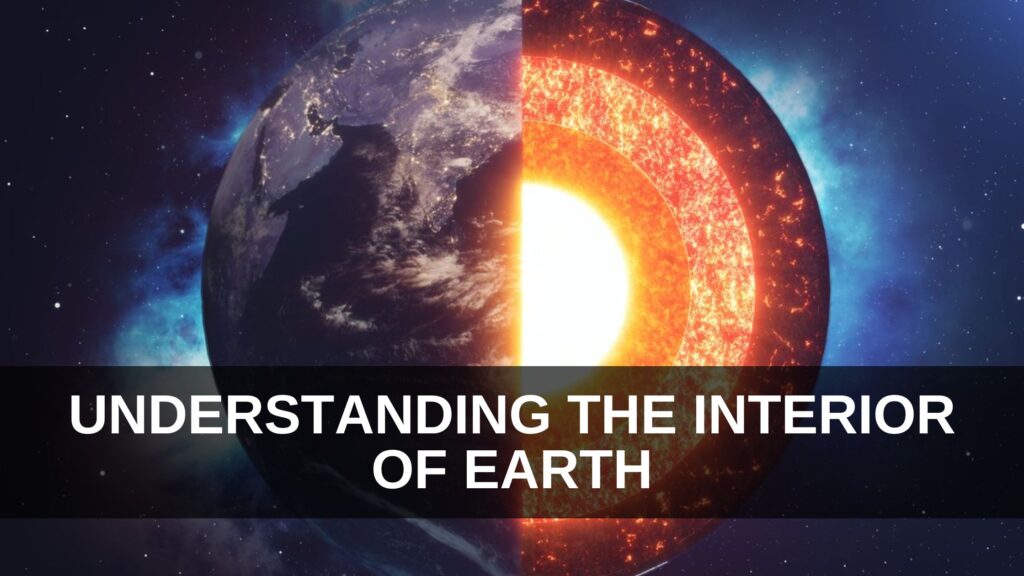The interior of Earth has long been a subject of study for geologists and seismologists. Earth is not a homogeneous solid ball; rather, it consists of different layers, each with distinct characteristics. Various processes occurring in Earth’s interior shape landforms, indirectly influencing human life.
Studying the Earth’s interior is essential for understanding physiographic characteristics, endogenic processes, earthquakes, and geological phenomena. The Earth’s surface is primarily a result of processes operating within its interior.
Download notes of Longitude and Latitude for UPSC
Endogenic and Exogenic Processes
Endogenic Processes (Beneath the Surface)
Endogenic processes originate within the Earth and are driven by internal energy. The primary sources of this energy include radioactivity, rotational and tidal friction, and primordial heat. These processes contribute to geological activities like volcanic eruptions and earthquakes.
Exogenic Processes (On the Surface)
Exogenic processes operate externally on the Earth’s surface. These processes, such as weathering, erosion, transportation, and deposition, are influenced by the hydrosphere, atmosphere, and biosphere. They continuously reshape the Earth’s surface.
Studying Earthquakes and the Interior of Earth
Earthquakes occur within the Lithosphere, approximately 200 km beneath the surface. Seismic waves generated by earthquakes provide crucial insights into Earth’s internal structure. Scientists classify information sources about the Earth’s interior into direct and indirect categories.
Direct Sources of Information
- Mining: Deep mines, such as South African gold mines (3-4 km deep), provide direct access to Earth’s materials.
- Scientific Projects:
- Deep Ocean Drilling Project
- Integrated Ocean Drilling Project (Deepest drill: Kola Peninsula, Arctic Ocean, 12 km deep)
- Volcanic Eruptions: Magma ejected from volcanoes provides observable material from the Earth’s interior.
Indirect Sources of Information
- Meteors: These have compositions similar to Earth’s deep interior.
- Pressure & Temperature Variations: Scientists estimate temperature, pressure, and density changes with depth.
- Gravitational and Magnetic Field Studies: Variations in gravity and magnetism help determine mass distribution within Earth’s crust.
- Seismic Activity: Seismic waves offer a complete picture of Earth’s layered interior.
Earthquakes and Their Role in Understanding Earth’s Interior
Definitions Related to Earthquakes
- Focus (Hypocenter): The point where seismic energy is released.
- Epicenter: The surface location directly above the focus.
- Seismograph: Instrument that records earthquake waves.
- Seismogram: The chart displaying recorded waves.
Types of Earthquake Waves
- Body Waves (Travel through Earth’s interior)
- P-waves (Primary Waves): Longitudinal waves that move parallel to the wave direction.
- S-waves (Secondary Waves): Transverse waves that create crests and troughs.
- Surface Waves (Most Destructive)
- Love Waves: Move side to side.
- Rayleigh Waves: Move in rolling motions.
Shadow Zone Formation
Seismographs reveal that seismic waves behave differently as they pass through Earth’s layers, creating shadow zones:
- 105°-145° from the epicenter: No direct P or S waves.
- Beyond 145°: Only P-waves are recorded since S-waves cannot travel through liquid.
Volcanoes and the Earth’s Interior
Volcanoes serve as a natural window into the Earth’s interior by bringing deep material to the surface. Volcanic activity is classified into:
- Active Volcanoes: Erupt frequently.
- Dormant Volcanoes: Have not erupted in a long time but may erupt again.
- Extinct Volcanoes: Unlikely to erupt in the future.

Structure of the Interior of Earth
The Earth’s interior is divided into layers, separated by transition zones known as discontinuities.
Major Layers of Earth
- Crust (Outer Layer):
- Continental Crust: 30-70 km thick, composed of light felsic rocks (sial: silica & aluminum).
- Oceanic Crust: 5 km thick, composed of dense mafic rocks (sima: silica & magnesium).
- Mantle (Middle Layer):
- Extends up to 2900 km, makes up 84% of Earth’s volume.
- Composed of silicates rich in iron and magnesium.
- Asthenosphere (Upper Mantle): Semi-fluid layer responsible for plate movements.
- Core (Innermost Layer):
- Outer Core: Liquid iron-nickel (nife), responsible for Earth’s magnetic field.
- Inner Core: Solid iron due to immense pressure, with temperatures reaching 5500°C.
Key Discontinuities
- Conrad Discontinuity: Between continental and oceanic crust.
- Mohorovičić Discontinuity (Moho): Between crust and mantle.
- Gutenberg Discontinuity: Between mantle and outer core.
- Lehmann Discontinuity: Between outer and inner core.
Processes Inside the Earth
The Earth’s internal heat originates from:
- Primordial Heat: Trapped since Earth’s formation.
- Radioactive Decay: Elements like uranium and thorium generate heat.
Heat transfer within the mantle occurs through mantle convection currents and mantle plumes, which influence volcanic and seismic activities.
Download notes of Geography as a discipline UPSC Notes
FAQs about the Interior of Earth
Q1. Why do we study the Earth’s interior?
Understanding the Earth’s interior helps analyze landforms, predict earthquakes, and explore geological processes. It also aids in resource exploration and understanding plate tectonics.
Q2. What are endogenic and exogenic processes?
- Endogenic Processes: Occur inside the Earth due to internal heat (e.g., volcanic activity, earthquakes).
- Exogenic Processes: Occur on the surface due to external forces (e.g., weathering, erosion).
Q3. How do earthquakes help us study the Earth’s interior?
Seismic waves generated by earthquakes travel through different layers of the Earth. Their speed, direction, and shadow zones provide insights into Earth’s composition and structure.
Q4. What is the difference between the lithosphere and the asthenosphere?
- Lithosphere: The rigid outer layer (crust + upper mantle), where tectonic plates exist.
- Asthenosphere: A semi-fluid layer beneath the lithosphere, allowing plate movements.


